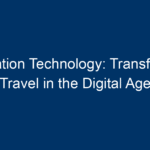The thought of traveling to distant stars and galaxies has fascinated humanity for centuries. With our current space transportation technology, journeys to even our closest neighboring planets can take months or years. However, the concept of space-time propulsion presents a revolutionary approach to unlocking the secrets of faster travel. In this article, we will delve into the science behind space-time propulsion, how it could change the future of human exploration, and the implication of these advancements on our understanding of the universe.
Understanding Space-Time Propulsion
What is Space-Time Propulsion?
Space-time propulsion refers to theoretical technologies that manipulate the four-dimensional fabric of space and time to achieve faster-than-light travel or significantly shorten the duration of space voyages. Unlike conventional propulsion systems in spacecraft, which rely on chemical reactions or nuclear energy, space-time propulsion operates by bending or warping space-time itself.
Theoretical Foundations
The foundation of space-time propulsion lies in the equations of general relativity proposed by Albert Einstein. According to these principles, massive objects warp the space-time around them, creating the effects of gravity. This foundational understanding has opened the door to explore unconventional methods of travel, such as warp drives and wormholes.
Types of Space-Time Propulsion
Warp Drives
One of the most famous concepts in the realm of space-time propulsion is the warp drive. Proposed by physicist Miguel Alcubierre in 1994, the warp drive theorizes a method of moving a spacecraft by contracting space in front of it and expanding space behind it. This would effectively allow the spacecraft to move faster than light without violating the laws of physics.
-
Mechanics of Warp Drives
Warp drives require a significant amount of exotic matter and energy, which remains largely theoretical. However, the concept has been explored through simulations and mathematical models, showcasing its potential. - Practical Challenges
While warp drives offer an exciting glimpse into the future of interstellar travel, they also come with formidable challenges in material science, energy resources, and engineering feasibility. The requirement of negative energy density to stabilize the warp bubble remains a significant hurdle.
Wormholes
Another intriguing possibility within the realm of space-time propulsion is the wormhole. Wormholes are hypothetical corridors through space-time that can connect distant points in an instant. If traversable wormholes exist, they could serve as shortcuts through the universe.
-
The Concept of Traversable Wormholes
Theoretical physicist Kip Thorne and his colleagues have proposed models for traversable wormholes that could potentially allow for human travel. However, these theories depend on the existence of exotic matter, similar to warp drives. - Potential Applications
Wormholes could revolutionize travel not only to distant galaxies but also facilitate instantaneous communication across vast distances, changing how we perceive and interact with time and space.
Implications of Space-Time Propulsion
Redefining Human Exploration
The advent of space-time propulsion would redefine our approach to space exploration. With the capability to reach other star systems within months rather than centuries, the possibilities for scientific discovery, resource acquisition, and even colonization would expand exponentially.
Technological Advancements
Developing technology for space-time propulsion could catalyze a host of advancements in related fields. Research in materials science, quantum physics, and energy systems could yield breakthroughs that impact everyday technologies, driving innovation far beyond space travel.
Ethical Considerations
As with any revolutionary technology, the ethical implications of space-time propulsion must be considered. Questions regarding resource allocation, potential militarization, and environmental impacts could arise. As we stand on the brink of such incredible possibilities, responsible stewardship of advanced technologies will be paramount.
Current Research and Developments
Scientific Endeavors
While theoretical work on space-time propulsion concepts has made significant strides, practical experiments remain in their infancy. Various institutions, including NASA and private space exploration companies, are currently investigating the feasibility of warp drives and wormholes.
International Collaboration
Space-time propulsion research is increasingly becoming a collaborative endeavor, with researchers across the globe contributing to various aspects of the science. International partnerships can pool resources, knowledge, and technology, accelerating advancements in this exciting field.
The Future of Space-Time Propulsion
Visionary Goals
As we strive to unlock the secrets of faster travel, visionary goals will play a crucial role. Establishing milestones for technological development and fostering public interest in space exploration will be necessary to garner support for advanced research initiatives.
Engaging the Public
Educating the public about the potential of space-time propulsion is vital. Science communication, public lectures, and outreach programs can inspire the next generation of scientists and engineers, facilitating a cultural shift towards prioritizing space exploration.
Investment in Research
Finally, securing funding for research into space-time propulsion technologies will be a critical factor determining the success of these initiatives. Governmental and private investments in space exploration can pave the way for unprecedented advancements in our understanding of the universe.
Conclusion: The Road Ahead for Space-Time Propulsion
In summary, space-time propulsion holds the promise of revolutionizing how we travel through the cosmos. Though still in the realm of theoretical physics, advancements in warp drives and wormhole technology could one day make interstellar travel a reality. While we navigate the challenges and ethical implications of this exciting frontier, it is crucial to engage in a thoughtful discourse about the future of human exploration.
Actionable Insights:
- Stay Informed: Follow scientific developments in space-time propulsion to understand emerging technologies.
- Support Science Education: Encourage interest in STEM fields to cultivate the next generation of innovators.
- Participate in Public Discourse: Engage in conversations about space exploration and its ethical implications to shape responsible policies.
Embracing the mysteries of space-time propulsion opens up a universe of possibilities. As we embark on this journey, let’s harness our curiosity and ingenuity to unlock the secrets of faster travel and explore the cosmos like never before.




